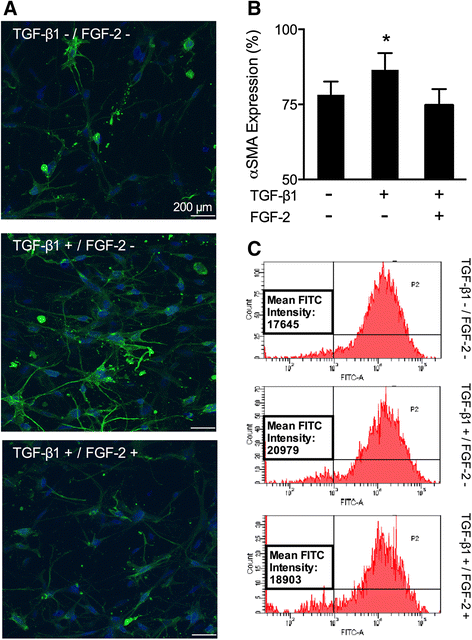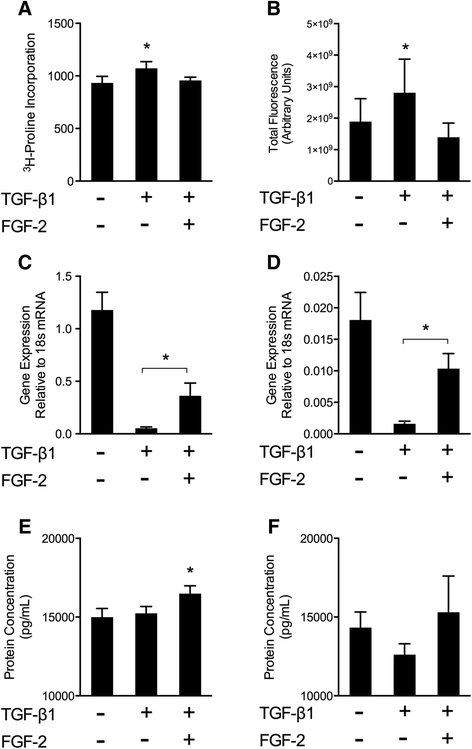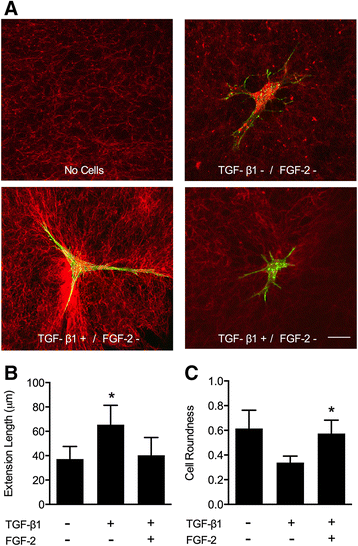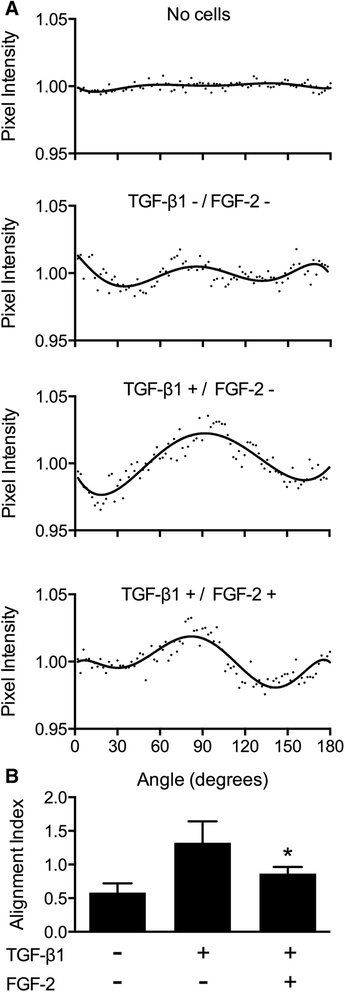Fibroblast growth factor-2 regulates human cardiac myofibroblast-mediated extracellular matrix remodeling
- PMID: 25948488
- PMCID: PMC4438633
- DOI: 10.1186/s12967-015-0510-4
Fibroblast growth factor-2 regulates human cardiac myofibroblast-mediated extracellular matrix remodeling
Abstract
Background: Tissue fibrosis and chamber remodeling is a hallmark of the failing heart and the final common pathway for heart failure of diverse etiologies. Sustained elevation of pro-fibrotic cytokine transforming growth factor-beta1 (TGFβ1) induces cardiac myofibroblast-mediated fibrosis and progressive structural tissue remodeling.
Objectives: We examined the effects of low molecular weight fibroblast growth factor (LMW-FGF-2) on human cardiac myofibroblast-mediated extracellular matrix (ECM) dysregulation and remodeling.
Methods: Human cardiac biopsies were obtained during open-heart surgery and myofibroblasts were isolated, passaged, and seeded within type I collagen matrices. To induce myofibroblast activation and ECM remodeling, myofibroblast-seeded collagen gels were exposed to TGFβ1. The extent of ECM contraction, myofibroblast activation, ECM dysregulation, and cell apoptosis was determined in the presence of LMW-FGF-2 and compared to its absence. Using a novel floating nylon-grid supported thin collagen gel culture platform system, myofibroblast activation and local ECM remodeling around isolated single cells was imaged using confocal microscopy and quantified by image analysis.
Results: TGFβ1 induced significant myofibroblast activation and ECM dysregulation as evidenced by collagen gel contraction, structural ECM remodeling, collagen synthesis, ECM degradation, and altered TIMP expression. LMW-FGF-2 significantly attenuated TGFβ1 induced myofibroblast-mediated ECM remodeling. These observations were similar using either ventricular or atrial-derived cardiac myofibroblasts. In addition, for the first time using individual cells, LMW-FGF-2 was observed to attenuate cardiac myofibroblast activation and prevent local cell-mediated ECM perturbations.
Conclusions: LMW-FGF-2 attenuates human cardiac myofibroblast-mediated ECM remodeling and may prevent progressive maladaptive chamber remodeling and tissue fibrosis for patients with diverse structural heart diseases.
Figures





Similar articles
-
Monocytes increase human cardiac myofibroblast-mediated extracellular matrix remodeling through TGF-β1.Am J Physiol Heart Circ Physiol. 2016 Mar 15;310(6):H716-24. doi: 10.1152/ajpheart.00309.2015. Epub 2016 Jan 22. Am J Physiol Heart Circ Physiol. 2016. PMID: 26801303
-
Featured Article: TGF-β1 dominates extracellular matrix rigidity for inducing differentiation of human cardiac fibroblasts to myofibroblasts.Exp Biol Med (Maywood). 2018 Apr;243(7):601-612. doi: 10.1177/1535370218761628. Epub 2018 Mar 4. Exp Biol Med (Maywood). 2018. PMID: 29504479 Free PMC article.
-
Cell therapy limits myofibroblast differentiation and structural cardiac remodeling: basic fibroblast growth factor-mediated paracrine mechanism.Circ Heart Fail. 2012 May 1;5(3):349-56. doi: 10.1161/CIRCHEARTFAILURE.111.965889. Epub 2012 Apr 16. Circ Heart Fail. 2012. PMID: 22508775
-
Biomarkers for the identification of cardiac fibroblast and myofibroblast cells.Heart Fail Rev. 2019 Jan;24(1):1-15. doi: 10.1007/s10741-018-9720-1. Heart Fail Rev. 2019. PMID: 29987445 Review.
-
Functions of exogenous FGF signals in regulation of fibroblast to myofibroblast differentiation and extracellular matrix protein expression.Open Biol. 2022 Sep;12(9):210356. doi: 10.1098/rsob.210356. Epub 2022 Sep 14. Open Biol. 2022. PMID: 36102060 Free PMC article. Review.
Cited by
-
Intersection of stem cell biology and engineering towards next generation in vitro models of human fibrosis.Front Bioeng Biotechnol. 2022 Oct 20;10:1005051. doi: 10.3389/fbioe.2022.1005051. eCollection 2022. Front Bioeng Biotechnol. 2022. PMID: 36338120 Free PMC article. Review.
-
Spatiotemporal delivery of basic fibroblast growth factor to directly and simultaneously attenuate cardiac fibrosis and promote cardiac tissue vascularization following myocardial infarction.J Control Release. 2019 Oct;311-312:233-244. doi: 10.1016/j.jconrel.2019.09.005. Epub 2019 Sep 12. J Control Release. 2019. PMID: 31521744 Free PMC article.
-
ColXV Aggravates Adipocyte Apoptosis by Facilitating Abnormal Extracellular Matrix Remodeling in Mice.Int J Mol Sci. 2020 Jan 31;21(3):959. doi: 10.3390/ijms21030959. Int J Mol Sci. 2020. PMID: 32024006 Free PMC article.
-
Atrial Cardiopathy and Sympatho-Vagal Imbalance in Cryptogenic Stroke: Pathogenic Mechanisms and Effects on Electrocardiographic Markers.Front Neurol. 2018 Jun 19;9:469. doi: 10.3389/fneur.2018.00469. eCollection 2018. Front Neurol. 2018. PMID: 29971041 Free PMC article.
-
Characterization of cardiac fibroblast-extracellular matrix crosstalk across developmental ages provides insight into age-related changes in cardiac repair.Front Cell Dev Biol. 2024 Feb 16;12:1279932. doi: 10.3389/fcell.2024.1279932. eCollection 2024. Front Cell Dev Biol. 2024. PMID: 38434619 Free PMC article.
References
-
- Spinale FG. Matrix metalloproteinases: regulation and dysregulation in the failing heart. CircRes. 2002;90(5):520–30. - PubMed
Publication types
MeSH terms
Substances
LinkOut - more resources
Full Text Sources
Other Literature Sources
Research Materials
Miscellaneous

